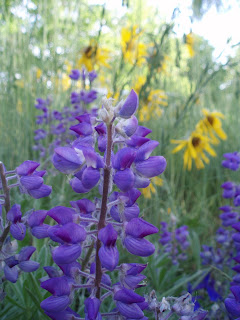
Here is a brief update of a project I completed earlier this spring- a small makeover to our front yard prairie, and a couple of pictures of what is flowering now (above is sticky geranium, Geranium viscosissimum, this is easy to grow, and quick to flower- unlike the species pictured at the end of the post) .
I moved the front path (taking my own advice), added a hill, and added some interpretive signs. The whole point was to correct some design shortcomings and embrace the public-ness of our front yard. This project was also a great opportunity to eradicate some weeds that have been difficult to control (Kentucky bluegrass, Poa pratensis , in particular), by digging up a couple of big sections.

All the plants we installed in the new area came from other places in our yard. I have a lot of fun digging up plants from our yard that are volunteers in the cracks in the sidewalk and other places, growing them in our nursery for a couple of weeks and planting them elsewhere int he yard. Most of these plants can from the area that our greenhouse now occupies.
Below is a picture of death camas (Zigadenus venenosus), a pretty severe sounding name. I hear it is not really deadly, but it will just make you sick, but I am not going to try it. It is a really neat little plant, and looks a lot like a tiny bear grass (Xerophyllum tenax). It is really easy to grow (provided you can get the bulbs). We initially got ours from some plant salvages (plants we rescued from a development in Missoula), but since them, they have seeded well and we have a lot of volunteers.

As far as design elements, our front path has always annoyed me- a straight line leading right to the door. Similar to the back yard, I broke up the concrete and rearranged it to a curving and wider, more inviting path.

Adding the hill added topography and some visual interest, and also helped to obscure the front entrance a little. This hill also provides a nice place to showcase 30 or so bitterroots (Lewisia rediviva) that I transplanted from our backyard when I dug up plants to install the greenhouse.
Below is a (I think- my wife might correct me) silky lupine (Lupinus sericeus), and in the background is arrowleaf balsamroot (Balsamorhiza sagittata). Both are easy to grow, but as I mentioned here you need patience 4-7 years before that flower, and don't try to transplant them- their taproots are huge!

Since our front yard is a marked departure from the typical turf grass monoculture and token specimen trees so familiar to the urban/ suburban landscape, the addition of interpretive signs helps to explain what our landscape goals are. In the past, we have had signs that identify plants and signify this as a backyard wildlife habitat, but these new signs go one step further and explain Missoula prairies, wildlife gardening and why we do not have a lawn.
 Below are two pictures of our front yard prairie, the top one is before (May 2005) and the bottom one is after (May 2009) this little makeover project. Not a huge change, but I think it is substantially better. I really enjoy small changes and rearranging elements in the landscape.
Below are two pictures of our front yard prairie, the top one is before (May 2005) and the bottom one is after (May 2009) this little makeover project. Not a huge change, but I think it is substantially better. I really enjoy small changes and rearranging elements in the landscape. 

Much better! Now tell me, how do you break up concrete? I had it done in a small part of the back yard, and it involved two guys with a jack hammer taking turns for a very long time...I hesitate to repeat the ordeal, though there are some spots where I'd love dirt instead of concrete.
ReplyDeleteHi Town Mouse,
ReplyDeleteThanks for your comments!
I use a 6 lb sledge to break up the concrete into manageable pieces. It is a good combination of mass and precision. However, this is with 4-6" concrete with no rebar or wire mesh.
I have gotten a couple of questions about making an urbanite (broken concrete) path, so this sounds like a good idea for a post... Stay tuned.
Thanks again,
David
I just discovered your blog through GardenWeb I think. It's wonderful. I'm in Minnesota and always working on expanding the native plantings on my property. Do you know if Montana and Minnesota have similar native plants? If so your info would be really helpful for me.
ReplyDeleteHi Jo,
ReplyDeleteI am glad you are enjoying my blog.
Montana and Minnesota have very different plant communities, mainly dictated by moisture (we get 1/2 to 1/3 of the precipitation). Although there are prairies in both states, because we have much less precipitation, we have short grass prairies, and Minnesota and teh mid western states have (or had) tall grass prairies. However, there are many species that occur in both places, and many of the genera are similar.
I hope this is helpful.
Thanks for your comments!
David
Simply gorgeous. I would love to get my husband to get onboard for something like this. I think you did a great job. Your house looks like a jewel set in a fancy mounting.
ReplyDeleteI adore simple wild flowers!!!
ReplyDelete